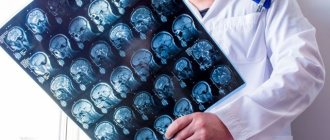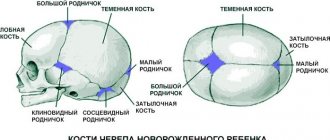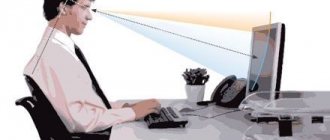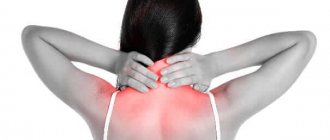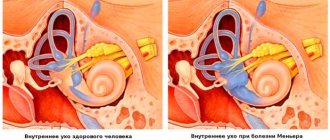The scalp becomes numb most often due to osteochondrosis of the cervical spine, when the nerve fibers are pinched by bony protrusions. The cause may be compression by tense neck muscles due to an uncomfortable posture during sleep or work, or muscle spasm due to neck pain.
The frontal part of the head becomes numb with trigeminal neuralgia, and numbness of the ear and half of the face occurs with neuritis of the facial nerve. Unilateral damage is typical for migraine attacks and strokes, and the vertex loses sensation when the occipital nerve is pinched.
Dangerous symptoms include sudden numbness with general weakness and lack of sensation in half of the head, arm or arm and leg on one side, then you need to call an ambulance.
For a routine examination, you need to contact a neurologist. He conducts a study of the neurological status (skin tests, reflexes), prescribes x-rays of the cervical spine, MRI, and blood tests. To treat radicular syndrome (the most common cause), painkillers (Diclofenac), vitamins (Milgamma), improving blood circulation (Trental), muscle relaxants (Sirdalud), exercise therapy, massage, and physiotherapy are prescribed.
Head goes numb: causes, sign of what disease
If your head goes numb, this is due to a deterioration in the sensitivity of the scalp, the causes being diseases:
- cerebral vessels - inflammation (vasculitis), blockage with deterioration of blood supply (stroke or temporary ischemic attack);
- traumatic origin - cranial, cervical spine;
- hereditary - for example, narrowing of the openings through which the spinal cord root passes;
- with compression of the nerve fiber - by muscles (with spastic contraction or prolonged tension), bone outgrowths with osteochondrosis, space-occupying formation (tumor, blood accumulation, inflammatory compaction, aneurysm);
- neuritis of the facial nerve;
- trigeminal neuralgia;
- infectious (herpes, meningitis);
- metabolic – diabetes mellitus, lack of vitamin B12, B1;
- against the background of lead poisoning, other toxic compounds, and medications.
Most diseases occur with concomitant symptoms, the patient feels severe weakness, dizziness, speech, vision, and movements may deteriorate. If the general condition is normal, but only, for example, the scalp under the hair becomes numb, then this is usually a manifestation of prolonged muscle tension. This happens with sedentary work, incorrect body position during sleep, headaches and after a long trip on a bus, train or plane.
The location of the numbness zone is also important. In neurological and vascular diseases, it has clear and permanent outlines; by its location, a neurologist can determine the location of nerve damage.
If there is a variety of symptoms (tingling in different parts of the face, burning, heat, numbness), then a suspicion of neurosis or neurocirculatory dystonia arises. They often occur against the background or after stress overexertion.
Leather
If the scalp becomes numb, then most often you need to look for the cause in the cervical spine. Osteochondrosis is the most common cause; it causes irritation of the spinal cord roots by bone outgrowths (osteophytes), which patients call “salt deposition.”
If the size of the osteophytes increases, then compression begins with pain during movements and impaired sensitivity. Usually the numbness spreads to the head, neck, and sometimes extends to the arm.
If it shrinks (squeezes) the scalp, this sensation may be confused with a decrease in sensitivity. This is especially common in the setting of tension headaches. Patients describe it as tension, tightening or squeezing. Most often it is symmetrical, sometimes bringing the head and face together on one side. This disease is characterized by the appearance of symptoms after the action of a provoking factor:
- stress, lack of sleep;
- incorrect static posture;
- visual strain;
- long break in meals;
- staying in a stuffy room, heat, cold;
- anxiety, depression;
- high blood pressure;
- infection;
- hormonal disorders (usually premenstrual syndrome, menopause).
Forehead, frontal part
Trigeminal neuralgia
Numbness of the forehead (frontal part of the head) is possible with trigeminal neuralgia. This disease is characterized by painful attacks of the type of electric discharges, after which the sensitivity of the facial skin is impaired. Since the forehead is innervated by the superior orbital branch of this nerve, when it is damaged, skin numbness, tingling, and a feeling of cold occur. Causes of neuralgia include:
- vascular diseases - congenital tortuosity, aneurysm (expansion of the area), arterial hypertension, atherosclerosis;
- tumors of the brain, skull bones;
- sinusitis;
- traumatic brain injury;
- changes in bite, dental procedures;
- herpes.
Neuralgia can be suspected if pain occurs after touching the skin of the face or contraction of facial muscles when eating or talking.
Right side or left
If the right or only the left side of the head hurts and goes numb, then the cause may be neuritis of the facial nerve. It is also called Bell's palsy, since one of the manifestations is weakness of the facial muscles. The patient experiences pain behind the ear, then half of the face goes numb, on the affected side the nasolabial fold is smoothed, the corner of the mouth is drooping. Then a skew of the facial part of the head occurs on the healthy side, and on the affected side, movements of the facial muscles become impossible.
Unilateral numbness and asymmetry of the face also occurs with acute cerebrovascular accident. Then, when trying to smile, one half lags behind the other (a crooked smile), the eyebrows rise to different heights, and if you ask the patient to stick out his tongue, it deviates to the side. There may be loss of vision in one eye. Speech becomes slurred. Usually, with a decrease in sensitivity, weakness is felt in the arm or arm and leg on one side, the patient will outgrow the sensation of touching half of the upper lip.
Symptoms may disappear within a day, then a diagnosis of transient (transient) ischemic attack is made. If symptoms persist for more than 24 hours, a stroke develops. The causes of deterioration of cerebral circulation include atherosclerosis, hypertension, and osteochondrosis.
Crown, upper part of the head
Numbness and tingling in the crown and upper part of the head can be associated with pinching (neuralgia) of the occipital nerve. This disease is provoked by:
- cervical osteochondrosis;
- infectious diseases (sore throat, mumps);
- inflammation of the lymph nodes (lymphadenitis) of the occipital, behind-the-ear group;
- neck injuries, surgeries;
- hypothermia;
- prolonged muscle tension.
Painful shooting sensations from the back of the head to the crown, from the neck to the shoulders and shoulder blades are typical. Most often they are one-sided, but they can spread to both sides.
Ear and head part
Numbness that starts from the ear and then covers half of the head is typical of neuritis of the facial nerve.
The most common cause is hypothermia and inflammation of the middle ear (otitis media). Similar signs may also appear against the background of herpes, mumps, or after an injury. Less commonly, such symptoms occur due to an acute cerebrovascular accident (ischemic stroke), a tumor, or an infectious lesion of the brain (encephalitis).
Half head, whiskey
Numbness of half the head or a predominant deterioration of sensitivity in the temples is typical for a migraine attack with aura. At the same time, there may be tingling in the fingertips.
Sometimes numbness spreads to the entire arm, part of the neck and body. You may experience ringing in the ears or unusual sounds or smells. Half of the head also goes numb in patients with an epileptic attack, a transient disorder of cerebral circulation.
Also hands
Numbness of the head and arms is a typical sign of cervical osteochondrosis, and can also be caused by:
- trauma, especially vertebral subluxations;
- congenital anomalies of the structure of the spine;
- curvature of the spinal column;
- scoliosis.
In older people, the height of the intervertebral discs may decrease (spondylosis).
Damage to the cervical and upper thoracic roots occurs with herpes zoster. Impaired sensitivity of the scalp and hands is caused by circulatory disorders (for example, diabetes mellitus, vasculitis). Less commonly, tumors of the spinal cord or brain are found in the patient.
Numbness in various parts of the body is typical of the onset of multiple sclerosis. This is a disease of autoimmune origin. When it occurs, the body produces antibodies to the nerve sheath, an inflammatory reaction develops, followed by damage to the nerve fiber, replacing it with scar tissue.
Most often, the patient is initially concerned about weakness in the legs, back pain, tingling in the limbs, blurred vision, and dizziness are also possible. As the disease progresses, muscle spasms are observed, making it difficult to walk, the functioning of the intestines and bladder is disrupted, and problems with swallowing food arise.
If the back of the head goes numb: reasons
When the back of the head goes numb, most often the cause should be sought in the cervical spine. This is typical for infringement and/or irritation of the 2nd and 3rd roots of the spinal cord. They exit through a narrow intervertebral foramen, pressure is exerted on it by bony protrusions or congested veins due to obstruction of blood outflow. The most common disease with radicular syndrome is osteochondrosis.
Prerequisites for infringement also become:
- decreased height of intervertebral discs and their hernial protrusion;
- violation of the shape of the arcuate processes (congenital or after injury);
- vertebral displacement due to instability;
- excessive stress on the spine;
- sedentary lifestyle;
- obesity;
- hypothermia;
- bone abnormalities (for example, an accessory growth or a narrowed foramen).
Numbness in the back of the head can also be caused by rarer causes:
- syphilis;
- tuberculosis;
- infectious inflammation of the membranes of the spinal cord (spinal meningitis);
- osteomyelitis (bone suppuration) of the spine;
- tumor of the spinal cord or root, vertebra.
Some patients experience headaches due to high blood pressure. This can be explained by the fact that the arteries become tense, compress the veins and venous outflow becomes difficult. This leads to irritation of the spinal root. Typically, such symptoms develop with a long course of hypertension and widespread atherosclerosis.
Feeling of numbness in the neck - where to go
If you have a feeling of numbness in your neck, you need to make an appointment with a neurologist. This specialist has the necessary level of professional competence to identify the potential cause and eliminate it.
In most cases, numbness in the back of the neck is caused by osteochondrosis and its complications. In this situation, the best choice would be a vertebrologist. This doctor will be able to develop a course of restorative therapy, thanks to which you will be able to completely restore the lost health of the spinal column.
If numbness in the skin of the neck or muscles appears after a traumatic impact (fall, blow, participation in an accident, or simply emergency braking while driving in a car with the head thrown back), then you should immediately visit a traumatologist. This doctor will order an x-ray to rule out the possibility of a fracture or crack in the bone tissue of the spinal column. This is a very dangerous condition in which complete paralysis of the entire body can quickly develop. Therefore, you should not hesitate to seek medical help.
After contacting a neurologist or vertebrologist, an X-ray examination will also be prescribed. It will reveal indirect signs of the development of osteochondrosis (decrease in the height of the intervertebral spaces), deforming spondyloarthrosis (narrowing of the joint space), the development of osteophytes and disruption of the position of the vertebral bodies with their possible displacement. For further diagnosis, you will need to conduct an MRI examination, ultrasound examination of the vessels of the neck and brain. Consultation with an otolaryngologist, pulmonologist and cardiologist may be required.
If numbness of the neck muscle is caused by endocrine and vascular problems, such as diabetic angiopathy or atherosclerosis, then additional treatment will be required from an endocrinologist and vascular surgeon.
Why does my head go numb and dizzy?
Ready to go numb and dizzy with vascular diseases of the brain (for example, with dyscirculatory encephalopathy).
It is most often associated with atherosclerosis, hypertension, and diabetes, but in every third person with such symptoms, osteochondrosis and spinal instability in the cervical region are detected.
Risk factors include abnormal development of the vertebral artery, systemic vasculitis (inflammatory damage to blood vessels), heart rhythm disturbances, persistent or frequent hypotension (low blood pressure).
A pre-fainting state with darkening of the eyes, dizziness, ringing in the ears and a feeling of numbness in the scalp, hands and face occurs during panic attacks. They are one of the manifestations of neurosis, neurocirculatory dystonia. Sudden loss of sensation on only one side of the face and weakness of the limbs is dangerous, as it can be a harbinger of a stroke.
Treatment of numbness in the neck, neck and shoulders
In order to begin effective and safe treatment, you must first make an accurate diagnosis. Then the doctor must try to eliminate the factor that interferes with the conduction of the nerve impulse along the sensory types of axons.
For example, if numbness of the neck and shoulders is associated with infiltrative edema due to congestion or an inflammatory aseptic reaction, then several sessions of osteopathy will help. An experienced doctor will restore physiological microcirculation of blood and lymphatic fluid. The pressure on the sensory axons will ease. This will help restore sensitivity in the area of pathological changes.
If numbness of the neck and back of the head is a symptom of osteochondrosis, then first of all it is necessary to restore the normal height of the intervertebral spaces. To do this, it is advisable to use the technique of manual traction of the spinal column. During the procedure, an experienced doctor will remove compression from the radicular nerves and their branches. It will restore the normal height of the intervertebral spaces. The cartilage tissue is straightened. This will promote the regeneration process.
But the elimination of pain and numbness does not mean that the disease is completely defeated. It is necessary to continue treatment until the damaged tissue is completely restored. For these purposes, the doctor develops an individual course of therapy. Depending on the identified disease, it may include the following types of exposure:
- massage of the neck and collar area - restores the normal tone of the muscle fiber, returning its ability to provide complete diffuse nutrition to the cartilage tissue of the intervertebral discs;
- osteopathy – starts the process of enhancing the trophism of all tissues, normalizes the elasticity of ligament and tendon fibers, eliminates the risk of fluid stagnation and the development of infiltrative edema of soft tissues;
- physiotherapy improves metabolism at the cellular level, accelerates regeneration processes;
- reflexology triggers tissue regeneration by tapping into the hidden reserves of the human body;
- Therapeutic gymnastics and kinesiotherapy strengthen the muscle frame and improve the condition of all tissues.
The course of treatment is developed for each patient individually. If you need help with neck numbness, make an appointment for a free appointment with our doctors at a manual therapy clinic in Moscow. You will be provided with comprehensive information about the possibilities and prospects for using our methods in your case of illness.
When urgent help is needed
Numbness of the head goes away on its own and quickly enough if it occurs after being in an uncomfortable position, but there are also symptoms for which you should immediately consult a doctor:
- sudden severe weakness;
- inability to move an arm or arm and leg on one side of the body;
- slurred speech;
- lag in movements on one half of the face;
- unbearable headache;
- sharp fluctuations in blood pressure;
- increased body temperature;
- loss or deterioration of vision and hearing.
Diagnosis of the condition
To make a diagnosis, you need to contact a neurologist, he will conduct an examination and determine the localization of numbness using skin tests, then identify the circumstances of the complaints (for example, previous trauma, infection, hypothermia). Information about concomitant diseases (hypertension, diabetes) will be important. The rate of increase in symptoms allows you to narrow the direction of the diagnostic search. For example:
- instant numbness occurs with stroke and injury;
- during infection, symptoms increase from several hours to 2-3 days;
- weeks and months covering an increasingly larger area are typical for the tumor process, multiple sclerosis.
To clarify the affected area and the cause of numbness, the following is prescribed:
- X-ray of the cervical spine;
- Ultrasound of head and neck vessels;
- neurophysiological testing (electroneuromyography) – determining the speed of propagation of a nerve signal;
- MRI of the brain;
- blood tests: general, biochemistry (renal tests, glucose, glycated hemoglobin, magnesium, calcium, potassium, sodium), level of vitamin B12, folic acid;
- test for thyroid-stimulating hormone of the pituitary gland;
- immunological tests (for antibodies if infection is suspected, plasma protein electrophoresis).
The patient may need to consult an infectious disease specialist, endocrinologist, oncologist, or surgeon.
Treatment methods for loss of sensation in the head
The scope of treatment for loss of sensation in the head completely depends on the disease. For example, for the most common disease – osteochondrosis, the following is prescribed:
- painkillers from the group of non-steroidal anti-inflammatory drugs: Diclofenac, Ketonal, Ibuprofen;
- relaxing muscles: Mydocalm, Sirdalud;
- decongestants: Hypothiazide, Lasix;
- stimulating metabolic processes: Rumalon, Actovegin;
- improving nerve functions: Milgamma, Berlition;
- facilitating venous outflow: Troxevasin, Aescusan;
- normalizing microcirculation (Trental, Xanthinol nicotinate);
- activating the transmission of nerve impulses: Neuromidin.
The required group of drugs is selected based on the prevailing symptoms. In addition to medications, it is recommended to wear a Shants collar to relieve the load on the spine. Physiotherapy helps well - in the acute stage, UHF, the introduction of Hydrocortisone with ultrasound, acupuncture, and during the recovery period massage and physical therapy are indicated.
A similar approach is used in the treatment of neuritis and neuralgia. If there is a tumor process, a herniated disc, or spinal instability, surgery is needed. It is also recommended if the full course of drug therapy is ineffective.
If the cause of numbness is cerebral vascular disease, then the following drugs are used:
- cholesterol-lowering drugs (Vasilip, Roxera);
- calcium channel blockers (Corinfar, Nimotop);
- improving cerebral blood flow (Pentilin, Bilobil);
- reducing blood viscosity (Curantil, Aspirin);
- protecting against lack of oxygen (Nootropil, Ceraxon);
- B vitamins (Neurobion, Milgamma).
How to treat numbness?
All existing treatment methods, both ultra-new and traditional, which the Alan Clinic Center for Neurology and Orthopedics uses in its work, are safe and exclude surgical intervention.
The treatment process is always a comprehensive program with an individual approach to each of our patients. The treatment methods used, consisting mainly of non-drug methods, are acceptable even for the treatment of infants, pregnant and lactating mothers.
We have at our disposal the following methods:
- Manual therapy
- Osteopathy is treatment done by a doctor, with a gentle effect on the musculoskeletal system, nervous and vascular systems, and internal organs.
- Medical massage
- Acupuncture - exposure to biologically active points with microneedles.
- Laser reflexology is a painless effect on reflexogenic zones and points.
- Tsubotherapy is a gentle effect on the reflex points of the body.
- Pharmacopuncture is the introduction of medicinal drugs of natural origin to the source of the problem.
- Plasma therapy is the introduction of the patient’s own purified blood into the site of the disease.
- Isometric kinesiotherapy - individual gymnastic techniques/exercises, according to indications, with elements of joint massage.
- Kinesiotherapy using the Exart installation
- Kinesio taping
- Ozone therapy is treatment with active oxygen.
- Physiotherapy
- Physiotherapy with enzyme preparations
- Medical droppers
- Hirudotherapy - treatment with leeches.
- Botulinum therapy is treatment with botulinum toxin.
- Intra-articular injection of synovial fluid endoprostheses
- Intra-articular blockades
All methods are recognized by official medicine, and doctors using them have appropriate certificates. The decision on the need to use certain medications during the course of treatment is made by the doctor, based on the complexity and severity of the disease, concomitant diseases, as well as the diagnosis.
Prevention measures
To reduce the risk of spinal diseases, it is recommended:
- monitor your posture while working, change body position;
- do therapeutic exercises daily;
- If you have pain or discomfort in the neck, consult a doctor immediately;
- undergo preventive courses of massage, physiotherapy, and take medications if necessary;
- Avoid hypothermia and sudden movements.
Vascular complications occur less frequently in patients who maintain blood pressure, blood sugar and cholesterol within normal limits. It is also important to quit smoking, alcohol abuse, and reduce body weight if you are obese.
The scalp becomes numb most often due to osteochondrosis of the cervical spine. The cause may be inflammation, pinched nerves, blockage or spasm of the artery supplying the brain (stroke, migraine). Numbness can be a consequence of injury, infection, and less commonly a tumor or multiple sclerosis.
How to help yourself
The reasons why the back of the head goes numb can be different. These are diseases or destruction of nerve fibers. In addition to examinations by a doctor, you need to pay attention to prevention. You need to do exercises. Choose several exercises, after which the muscle tissues pleasantly relax and the body is saturated with energy. Sudden body movements should be avoided.
It is preferable to check your own sleeping place. Is the bed too soft and is the pillow chosen correctly? Before going to bed, you should try to ventilate the bedroom so that there is enough oxygen. Unlike other formed elements in the body, neurons die very quickly due to lack of oxygen.
The diet requires adjustment. It is necessary to provide the body with a vitamin complex and amino acids. It is advisable to learn to control your emotions so that stress does not arise.
